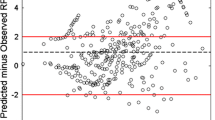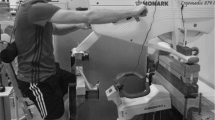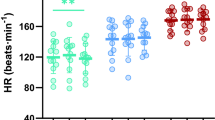Summary
To compare some psychophysiological responses to arm exercise with those to leg exercise, an experiment was carried out on electronically braked bicycle ergometers, one being adapted for arm exercise. Eight healthy males took part in the experiment with stepwise increases in exercise intensity every 4 min: 40—70—100—150—200 W in cycling and 20—35—50—70—100 W in arm cranking. Towards the end of each 4 min period, ratings of perceived exertion were obtained on the RPE scale and on a new category ratio (CR) scale: heart rate (HR) and blood lactate accumulation (BL) were also measured.
The responses obtained were about twice as high or more for arm cranking than for cycling. The biggest difference was found for BL and the smallest for HR and RPE. The incremental functions were similar in both activities, with approximately linear increases in HR and RPE and positively accelerating functions for CR (exponents about 1.9) and BL (exponents 2.5 and 3.3 respectively). When perceived exertion (according to the CR scale) was set as the dependent variable and a simple combination of HR and BL was used as the independent variable, a linear relationship was obtained for both kinds of exercise, as has previously been found in cycling, running, and walking. The results thus give support for the following generalization: For exercise of a steady state type with increasing loads the incremental curve for perceived exertion can be predicted from a simple combination of HR and BL.
Similar content being viewed by others
References
Asmussen E, Hemmingsen I (1958) Determination of maximum working capacity at different ages in work with the legs or with the arms. Scand J Clin Lab Invest 10: 67–71
Bar-Or O, Zwiren LD (1975) Maximal oxygen consumption test during arm exercise — reliability and validity. J Appl Physiol 38: 424–426
Bevegård S, Freyschuss U, Strandell T (1966) Circulatory adaptation to arm and leg exercise in supine and sitting positions. J Appl Physiol 21: 37–46
Borg G (1961) Interindividual scaling and perception of muscular force. Kungl Fys SÄlls Förhand, Lund, pp 105–115
Borg G (1962) Physical performance and perceived exertion. Studia Psychologica et Paedagogica, Series altera, Investigationes XI. Gleerup, Lund
Borg G (1970) Perceived exertion as an indicator of somatic stress. Scand J Rehab Med 2: 92–98
Borg G (1977) Physical work and effort. Wenner-Gren center Int Symp Series, vol 28. Pergamon Press, Oxford
Borg G (1982) A category scale with ratio properties for intermodal and interindividual comparisons. In: Geissler H-G, Petzold P (eds) Psychophysical judgment and the process of perception. VEB Deutscher Verlag der Wissenschaften, Berlin
Borg G, Dahlström H (1959) Psykofysisk undersökning av arbete på cykelergometer. Nord Med 62: 1383–1386
Borg G, Dahlström H (1960) The perception of muscular work. Umeå Vetensk Bibl Skrifts 5: 1–26
Borg G, Noble BJ (1974) Perceived exertion. In: Wilmore JH (ed) Exercise and sport sciences reviews, vol II. Academic Press Inc, New York
Borg G, Ottoson D (eds) (1986) The perception of exertion in physical work. Wenner-Gren Center Int Symp Series. MacMillan Press, London
Borg G, Ljungren G, Ceci R (1985a) The increase of perceived exertion, aches and pain in the legs, heart rate and blood lactate during exercise on a bicycle ergometer. Eur J Appl Physiol 54: 343–349
Borg G, Ljunggren G, Marks LE (1985b) General and differential aspects of perceived exertion and loudness assessed by two new methods (No 636). University of Stockholm, Department of Psychology, Stockholm
Borg G, van den Burg M, Hassmén P, Kaijser L, Tanaka S (1987) Relationships between increases in perceived exertion, heart rate and blood lactate concentration during cycling, running and walking
Davis JA, Vodak P, Wilmore JH, Vodak J, Kurtz P (1976) Anaerobic threshold and maximal aerobic power for three modes of exercise. J Appl Physiol 41: 544–550
DiCarlo SE (1982) Improved cardiopulmonary status after a two-month program of graded arm exercise in a patient with C6 quadriplegia: A case report. Phys Ther 62: 456–459
DiCarlo SE, Supp MD, Taylor HC (1983) Effect of arm ergometry training on physical work capacity of individuals with spinal cord injuries. Phys Ther 63: 1104–1107
Fardy PS, Webb D, Hellerstein HK (1977) Benefits of arm exercise in cardiac rehabilitation. Phys Sportsmed 5: 30–41
Frankling BA, Vander L, Wrisley D, Rubenfire M (1983) Aerobic requirements of arm ergometry: Implications for exercise testing and training. Phys Sportsmed 11: 81–90
Hellerstein HK, Franklin BA (1984a) Exercise testing and prescription. In: Wenger, Hellerstein (eds) Rehabilitation of the coronary patient, 2nd edn. John Wiley, New York, pp 197–284
Hellerstein HK, Franklin BA (1984b) Evaluating the cardiac patient for exercise therapy. Role of exercise testing. In: Franklin BA, Rubenfire M (eds) Clinics in sports medicine: Symposium on cardiac rehabilitation. WB Saunders, Philadelphia, pp 371–393
Hohorst HJ (1962) L (+) Lactat-Bestimmung mit Lactat-De-hydro-Genase und DPN. In: Bergmeyer HV (ed) Methoden der enzymatischen Analyse. Verlag Chemie, Weinheim
Kavanagh T, Shephard RJ (1973) The application of exercise testing to the elderly amputee. Can Med Ass J 108: 314–317
Mihevic PM (1981) Sensory cues for perceived exertion: A review. Med Sci Sports Exerc 3: 150–163
Nilsson S, Staff P, Pruett E (1975) Physical work capacity and the effect of training on subjects with long-standing paraplegia. Scand J Rehab Med 7: 51–56
Pandolf KB (1983) Advances in the study and application of perceived exertion. In: Terjung RL (ed) Exercise and sport sciences reviews, vol 11. Am Coll Sports Med Ser
Pollock ML, Miller HS, Linnerud AC, Laughridge E, Coleman E, Alexander E (1974) Arm pedaling as an endurance training regimen for the disabled. Arch Phys Med Rehab 55: 418–424
Schwade J, Blomqvist CG, Shapiro W (1977) A comparison of the response to arm and leg work in patients with ischemic heart disease. Am Heart J 94: 203–208
Shaw DJ, Crawford MH, Karliner JS, DiDonna G, Carleton RM, Ross J, O'Rourke RA (1974) Arm-crank ergometry: A new method for the evaluation of coronary artery disease. Am J Card 33: 801–805
Sjödin A, Jacobs I (1981) Onset of blood lactate accumulation and marathon performance. Int J Sports Med 2: 23–26
Sjöstrand T (1947) Changes in the respiratory organs of workmen at an ore smelting works. Acta Med Scand [Suppl] 196: 687–699
Skinner JS, Hutsler R, Bergsteinoa V, Buskirk ER (1973) Perception of effort during different types of exercise and under different environmental conditions. Med Sci Sports 5: 110–115
Vander LB, Franklin BA, Wrisley D, Rubenfire M (1984) Cardiorespiratory responses to arm and leg ergometry in women. Phys Sportsmed 12: 101–106
Wahlund H (1948) Determination of the physical working capacity. Zetterlund & Thelanders Boktryckeri AB, Stockholm
Wicks JR, Lymburner K, Dinsdale SM, Jones NL (1977) The use of multistage exercise testing with wheelchair ergometry and arm cranking in subjects with spinal cord lesions. Paraplegia 15: 252–261
Author information
Authors and Affiliations
Additional information
This study was supported by a research grant from The Bank of Sweden Tercentenary Foundation No. 85/291
Rights and permissions
About this article
Cite this article
Borg, G., Hassmén, P. & Lagerström, M. Perceived exertion related to heart rate and blood lactate during arm and leg exercise. Europ. J. Appl. Physiol. 56, 679–685 (1987). https://doi.org/10.1007/BF00424810
Accepted:
Issue Date:
DOI: https://doi.org/10.1007/BF00424810




